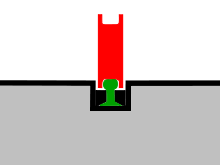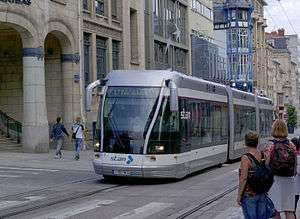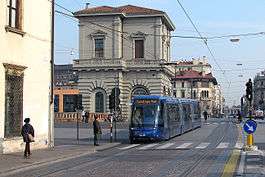Rubber-tyred trams


A rubber-tyred tram (also known as tramway on tyres, French: tramway sur pneumatiques) is a development of the guided bus in which a vehicle is guided by a fixed rail in the road surface and draws current from overhead electric wires (either via pantograph or trolley poles).
Two incompatible systems using physical guide rails exist, the Guided Light Transit (GLT) designed by Bombardier Transportation, and the Translohr from Lohr Industrie (currently made by Alstom and FSI). There are no guide bars at the sides but there is a central guidance rail that differs in design between the systems. In the case of Translohr, this rail is grasped by a pair of metal guide wheels set at 45° to the road and at 90° to each other. In the GLT system, a single double-flanged wheel between the rubber tires follows the guidance rail. In both cases, the weight of the vehicle is borne by rubber tires to which the guide wheels are attached, which make contact with the road on concrete roll ways designed to minimize impact on the ground. Power is usually supplied by overhead lines, rechargeable batteries, or internal combustion engines where there are no overhead wires.
Characteristics
The Translohr system operates as a guided vehicle at all times, while with the Bombardier system the vehicles can be driven autonomously as requirements dictate, such as journeys to the depot. Consequently, the Bombardier vehicles are legally considered buses, and must bear rear-view mirrors, lights and number plates, and are controlled with steering wheels and pedals like ordinary buses, though the steering wheel is not used when following the guidance rail. On the other hand, Translohr vehicles operate like standard trams and cannot move without guidance, so it is not classified as a bus and are not equipped with number plates.
These systems are intended to offer a more tram or light rail-like experience than a regular guided bus, and offer some advantages over steel-wheeled trams, such as the ability to climb steeper gradients (up to 13%), and quieter running around corners. The infrastructure installation can be less complicated than the installation of a complete tram line in an existing street. These systems have been likened to the tram equivalent of rubber-tyred metros, and they are also less efficient than steel-wheeled light rail vehicles. There is no evidence to prove the superiority of either guidance system. Both Bombardier and Translohr have had derailments during operation.[1][2]
List of rubber-tyred tram systems

Translohr
- Clermont-Ferrand tramway, France (STE4, since 2006)
- Padua tramway, Italy (STE3, since 2007)
- TEDA Modern Guided Rail Tram, Tianjin, China (STE3, since 2007)
- Mestre-Venice tramway, Italy (STE3, since 2010)
- Zhangjiang Tram, Shanghai, China (STE3, since 2010)
- Ile-de-France tramway Line 5, France (STE3, since 2013)
- Ile-de-France tramway Line 6, France (STE6, since 2014)
- Ayacucho Tram, Medellin, Colombia (STE5, since 2015)
Bombardier GLT
- Nancy Guided Light Transit, France (since 2001). About 60% of the single line is guided, with the remaining 40% operated as unguided trolleybuses. The line is due to be replaced by a conventional tramway in early 2023, with conversion work spanning from 2020 to 2022.[3]
- Caen Guided Light Transit, France (since 2002). The two-line network is entirely guided. In late 2016, it was decided that the line will be replaced by a conventional tramway, projected to open in 2019.[4] As of November 2017, the TVR line was due to close on 30 December, as work on the new tram line proceeded.[3]
CRRC ART
- Zhuzhou Tram, Hunan, China
See also
References
- ↑ "Further problems in Nancy". LRTA. November 20, 2002. Retrieved 18 July 2016.
- ↑ "The first modern guided tramway in China derails (国内首条现代导轨电车出轨)" (in Chinese). news.qq.com. August 20, 2007.
- 1 2 "Worldwide Review [regular news section]" (November 2017). Tramways & Urban Transit, p. 431. UK: LRTA Publishing. ISSN 1460-8324.
- ↑ "Alstom trams to replace Caen TVR" (January 2017). Tramways & Urban Transit, p. 7. UK: LRTA Publishing. ISSN 1460-8324.
